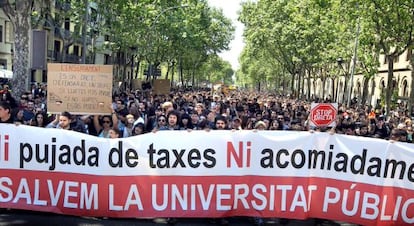Cutbacks in education present teachers with an impossible task
"They've increased class sizes from 15 to 18, and with these kids that's a lot"


At the end of the Corredor del Henares, an industrial area outside Madrid at its lowest economic ebb, is the town of Azuqueca. At its Arcipreste de Hita high school, Concha López, a teacher with 25 years of experience, spent her recess last Tuesday working with five children on an upcoming history exam. López gives curricular diversification classes, which focus on bringing the special education needs students up to speed.
"They've increased class sizes from 15 to 18, and with these kids that's a lot; if we can't work quickly enough so that they reach the level of the other students, diversification classes are pointless," López says. Two years ago the school had 78 teachers and 641 students. Now it has 54 teachers for 647.
Arcipreste de Hita is an example of what is happening all over Spain. Without official data and in the middle of a war of figures between the regions and labor unions, the CCOO union has sought an objective calculation: the budget for personnel had fallen since 2009 by the equivalent salary of 61,782 teachers.
This theoretical figure reached by the CCOO was calculated by dividing the drop in expenditure - 2.6 million euros - between 2009 and 2013 by the average salary of a Spanish school teacher, taking into account the various public sector wage reductions imposed during the same period. The figure represents a 12-percent reduction in the number of teachers in Spain, while the number of students in schools has risen by seven percent, around 400,000 children.
In the school years 2009-10 and 2010-11 the number of public school teachers was still on the rise nationwide, but last year it fell for the first time in 20 years. In April 2012 the government approved a royal decree that allowed the regions to fire greater numbers of teachers while raising the maximum amount of students permitted per class and the contact hours per week expected of teachers.
"We believe this estimation has been carried out without much accuracy, according to the figures we have available," said an Education Ministry spokesman. The ministry has always maintained that Spain's student-teacher ratio has historically been so good that even the cutbacks would not have an adverse effect.
Teachers at Arcipreste de Hita do not agree. The loss of 30 percent of its staff means that the school practically had to cease all extracurricular activities and recovery classes for students lagging behind. It also means that each teacher is responsible for 30 additional students, some of whom have behavioral issues or have had to fall back on charity food banks due to rampant unemployment among their parents.
"Aside from the loss of jobs, which naturally concerns us, what is abundantly clear is that the cutbacks are affecting the student body in general, but mostly among the most disadvantaged. They are losing extra classes, after-school activities, time in the library and tutorials, all of which contribute to compensating for the inequalities many children experience in learning," says Francisco García of the CCOO union's teaching department.
Of all the Spanish regions, Castilla-La Mancha has reduced its teaching personnel costs the most; by 20 percent, according to the CCOO study. At Arcipreste de Hita, says a teacher, Ismael Doñoro, the increase in student numbers has been exacerbated by the incorporation of international students - Chinese and Iranian children - who do not understand Spanish. "Before, one of our teachers would have had devoted time to looking after them; now whoever can spare the time does so on their breaks."
Tu suscripción se está usando en otro dispositivo
¿Quieres añadir otro usuario a tu suscripción?
Si continúas leyendo en este dispositivo, no se podrá leer en el otro.
FlechaTu suscripción se está usando en otro dispositivo y solo puedes acceder a EL PAÍS desde un dispositivo a la vez.
Si quieres compartir tu cuenta, cambia tu suscripción a la modalidad Premium, así podrás añadir otro usuario. Cada uno accederá con su propia cuenta de email, lo que os permitirá personalizar vuestra experiencia en EL PAÍS.
¿Tienes una suscripción de empresa? Accede aquí para contratar más cuentas.
En el caso de no saber quién está usando tu cuenta, te recomendamos cambiar tu contraseña aquí.
Si decides continuar compartiendo tu cuenta, este mensaje se mostrará en tu dispositivo y en el de la otra persona que está usando tu cuenta de forma indefinida, afectando a tu experiencia de lectura. Puedes consultar aquí los términos y condiciones de la suscripción digital.
Últimas noticias
From Andorra to Gibraltar, a black market for Ozempic exploits its success: ‘They’re the most sought-after products in the world’
From Hungary’s Orbán to Chile’s Kast: How Trump helps turbo charge the far right
Magnets in their heads: How some animals guide themselves using the Earth’s magnetic field
The brief rise and retreat of Generation Z in Mexico
Most viewed
- Why we lost the habit of sleeping in two segments and how that changed our sense of time
- Trump’s obsession with putting his name on everything is unprecedented in the United States
- Charles Dubouloz, mountaineering star, retires at 36 with a farewell tour inspired by Walter Bonatti
- The Florida Keys tourist paradise is besieged by immigration agents: ‘We’ve never seen anything like this’
- Living in a motorhome due to soaring housing prices in Madrid: ‘I got used to it quickly, but I don’t idealize it’








































